
Geografia Fisica e Dinamica Quaternaria
Scope & Guideline
Advancing Knowledge of Earth-Surface Processes
Introduction
Aims and Scopes
- Geomorphological Studies:
Research on landforms and the processes that shape them, including mapping and analysis of geomorphological features across various regions. - Glaciology and Climate Change:
Investigation of glaciers, their changes over time, and the implications for climate change, including studies on glacier mass balance and dynamics. - Hydrological and Meteorological Analysis:
Examination of rainfall trends, extreme weather events, and their spatial distribution, especially within the context of specific regions like Apulia, Italy. - Paleoenvironmental and Geological Research:
Studies focused on historical geological processes and environmental changes, including investigations into past climates and their impact on current landscapes. - Use of Advanced Technologies:
Application of modern technological methods such as UAV imaging and numerical modeling to enhance the understanding of geomorphological and glaciological phenomena.
Trending and Emerging
- Climate Change Awareness and Education:
Recent publications emphasize the role of geography in raising awareness about climate change impacts, highlighting the need for public engagement and education. - Extreme Weather Event Analysis:
There is a growing trend towards analyzing extreme weather patterns, such as rainfall and its implications for local environments, particularly in response to climate variability. - Technological Innovations in Geography:
The use of advanced technologies like UAVs and automated detection systems is becoming increasingly prominent, indicating a shift towards integrating more sophisticated methodologies in geographic research. - Holocene and Late Pleistocene Studies:
Research focusing on the Holocene and Late Pleistocene epochs is on the rise, as scientists seek to understand historical climate changes and their effects on current landscapes.
Declining or Waning
- Karst Studies:
Although previously a topic of interest, recent publications indicate a waning focus on karst environments and processes, as evidenced by fewer studies addressing this area. - Military Geographies:
Research related to the military uses of geographical features, such as caves, has become less frequent, suggesting a decline in this niche area of study. - Sediment Compaction and Tectonics:
Studies delving into sediment compaction and its effects on geological formations have decreased, possibly as more emphasis is placed on climate-related studies.
Similar Journals
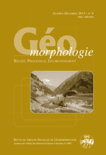
Geomorphologie-Relief Processus Environnement
Fostering Dialogue on Geomorphic PhenomenaGeomorphologie-Relief Processus Environnement is a pivotal journal in the field of Earth-Surface Processes, published by the GROUPE FRANCIAS GEOMORPHOLOGIE in France. With an ISSN of 1266-5304 and E-ISSN 1957-777X, the journal has established a notable presence since its inception in 1995. Though it operates without Open Access, it remains an essential resource, particularly in the niche area of geomorphology where it offers valuable insights into the interactions between relief features and environmental processes. The journal achieved a Q3 ranking in 2023 among Earth-Surface Processes, attesting to its significance in advancing research and discussions within this discipline, while it ranks #113/179 in Scopus, placing it in the 37th percentile. By fostering interdisciplinary dialogue and disseminating high-quality research, Geomorphologie-Relief Processus Environnement serves as a vital platform for researchers, professionals, and students eager to explore the complexities of our planet's surface processes.
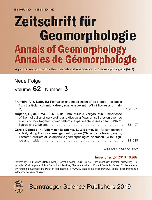
ZEITSCHRIFT FUR GEOMORPHOLOGIE
Innovative Perspectives on Landform Dynamics.ZEITSCHRIFT FUR GEOMORPHOLOGIE is a prestigious journal dedicated to the field of geomorphology, published by GEBRUDER BORNTRAEGER from Germany. With the ISSN 0372-8854 and E-ISSN 1864-1687, this journal serves as a vital platform for researchers, professionals, and students interested in understanding the dynamic processes that shape our Earth’s surface. The journal has consistently maintained a solid academic reputation, achieving a Q3 ranking in key categories including Earth and Planetary Sciences (miscellaneous), Earth-Surface Processes, and Geography, Planning and Development as of 2023. This reflects its position within the global scientific community; ranked at #93 out of 179 in Earth-Surface Processes, contributing to crucial discussions surrounding environmental changes and landform evolution. Although ZEITSCHRIFT FUR GEOMORPHOLOGIE is not an Open Access publication, it offers extensive insights and findings from converged years spanning from 1979 to 2019 and again from 2021 to 2022. The journal is located at Johannesstr 3A, D-70176 Stuttgart, Germany, and plays a pivotal role in advancing geomorphological research that impacts natural sciences, ecology, and planning strategies worldwide.

GEOMORPHOLOGY
Exploring the Dynamics of Earth's Surface.GEOMORPHOLOGY, published by Elsevier, is a leading journal that focuses on the study of landforms, along with the processes that shape them. Established in 1984, the journal has evolved to become an essential resource for researchers in the field of Earth-Surface Processes, currently holding a prestigious Q1 quartile ranking and occupying the 17th position out of 179 journals in Scopus, placing it within the top 10% of publications in this domain. This impact underscores its significance in advancing understanding within geosciences, providing a platform for both foundational and innovative research. GEOMORPHOLOGY publishes a diverse array of articles, from empirical studies to theoretical advancements, ensuring accessibility for a broad audience of students, professionals, and academics alike. With its commitment to high-quality research, this journal serves as a critical reference point for ongoing developments and discoveries in geomorphology.

QUATERNAIRE
Exploring Earth's Secrets, One Article at a Time.QUATERNAIRE is a reputable journal managed by the Société Géologique de France, specializing in the realms of Earth-Surface Processes and Geology. This esteemed publication has been a vital platform for scientific discourse since its inception, presenting compelling research and insights from both fields. With a significant impact in the academic community, it currently holds a Q3 quartile ranking in the 2023 Scopus categories, demonstrating its importance in disseminating knowledge related to geological phenomena. Although QUATERNAIRE does not have an open access model, it ensures that critical research is accessible to a wide audience, enhancing collaboration among geoscientists and environmental researchers. Based in France at 77, Rue Claude-Bernard, Paris F-75005, this journal continues to evolve its publication scope, welcoming contributions that delve into the intricacies of Earth's processes from 1990 to 2024. Researchers, professionals, and students alike will find valuable resources and inspiration within its pages, contributing to a deeper understanding of our planet's past and present.
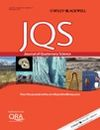
JOURNAL OF QUATERNARY SCIENCE
Advancing Understanding of Earth's Dynamic HistoryThe JOURNAL OF QUATERNARY SCIENCE, published by Wiley, stands as a premier platform for the dissemination of pivotal research in the fields of Arts and Humanities, Earth and Planetary Sciences, and Paleontology. With its ISSN 0267-8179 and E-ISSN 1099-1417, this esteemed journal has achieved an impressive Q1 ranking across multiple categories in 2023, highlighting its significant impact and relevance within the academic community. With a history extending from 1986 to 2024, it offers a treasure trove of knowledge, presenting cutting-edge studies that advance our understanding of Quaternary science. Although the journal does not operate under an Open Access model, it remains highly regarded, as evidenced by its Scopus rankings positioning it in the top percentiles within its categories. Researchers, professionals, and students alike will benefit from the robust insights and innovative research published in this journal, making it an essential resource for anyone engaged in the study of Quaternary environments and their implications on our planet’s history.

Research in Cold and Arid Regions
Fostering collaboration for sustainable environmental engineering.Research in Cold and Arid Regions, published by KEAI PUBLISHING LTD, is a premier journal dedicated to advancing knowledge in the fields of Earth-Surface Processes, Environmental Engineering, and Geosciences. With an ISSN of 2097-1583 and an E-ISSN of 2949-7302, this journal aims to provide a platform for researchers, professionals, and students to share their findings on the complexities of cold and arid environments, which have increasing significance in the context of climate change. The journal holds a Q3 ranking in multiple categories for 2023, reflecting its commitment to quality scholarship, though it also sits at the cusp of enhancing its potential impact in Geotechnical Engineering and Engineering Geology. Open Access options allow for wider dissemination of research findings, ensuring that valuable insights are accessible to a global audience. Based in Beijing, China, the journal is strategically positioned to address the unique challenges faced by arid and cold regions worldwide, making it an essential resource for scholars and practitioners focused on sustainable solutions for environmental issues.
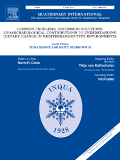
QUATERNARY INTERNATIONAL
Unveiling the Secrets of Geological Change.Quaternary International is a prestigious journal published by Pergamon-Elsevier Science Ltd, focusing on the interdisciplinary study of the Quaternary Period, which encompasses significant geological, hydrological, and climatic changes. With an ISSN of 1040-6182 and E-ISSN 1873-4553, it stands as a critical resource in the realm of Earth-Surface Processes, achieving a strong position within the academic community, evidenced by its 2023 Scopus rank of #32 out of 179 in this category, corresponding to an impressive 82nd percentile. Since its inception in 1989, this journal has provided valuable insights and contributed to the advancement of knowledge in the Earth and Planetary Sciences. Researchers, professionals, and students alike will find a wealth of original research articles, reviews, and case studies that inform and inspire further studies in the Quaternary sciences. Although the journal does not currently offer open access options, its reputation for rigorous peer review and impactful content underscores its significance in shaping scholarly discourse in the field.
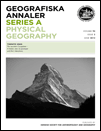
GEOGRAFISKA ANNALER SERIES A-PHYSICAL GEOGRAPHY
Bridging Research and Real-World ApplicationsGeografiska Annaler Series A-Physical Geography, published by Taylor & Francis Ltd, is a leading academic journal dedicated to the advancing field of physical geography. With a rich publication history spanning from 1979 to 2024, this journal stands out in its categories, being positioned in the Q2 quartile for both Geography, Planning and Development and Geology in 2023. The journal is recognized for its contribution to Earth and Planetary Sciences, evidenced by its Scopus rankings placing it in the top 31% and 32% of its respective disciplines. Belonging to a distinguished publisher from the United Kingdom, it provides a vital platform for researchers, professionals, and students to disseminate and engage with cutting-edge research. While the journal does not currently offer open access, it remains a pivotal resource for those involved in the study of physical geography, offering insights that enhance our understanding of the Earth's processes and environments.
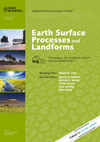
EARTH SURFACE PROCESSES AND LANDFORMS
Transforming Understanding of Earth’s Surface DynamicsEARTH SURFACE PROCESSES AND LANDFORMS is a renowned academic journal dedicated to the comprehensive exploration of dynamic processes shaping the Earth's surface. Published by Wiley, this esteemed journal has established itself as a leading platform in the fields of Earth and Planetary Sciences, Geography, Planning, and Development. With an impressive Impact Factor and ranked in the Q1 category for multiple disciplines, it consistently features cutting-edge research that contributes to the understanding of geomorphology, hydrology, and related environmental phenomena. Researchers and professionals can benefit from the journal's extensive repository of high-quality studies, making it a crucial resource for advancing knowledge in these vital areas. As it continues to converge from 1981 to 2024, EARTH SURFACE PROCESSES AND LANDFORMS remains pivotal for scholars aiming to engage in high-level discourse and discovery in Earth sciences.

Aeolian Research
Charting New Terrains in Aeolian ResearchAeolian Research, published by ELSEVIER SCI LTD, is a leading academic journal in the fields of Earth-Surface Processes and Geology, holding a prestigious Q1 category ranking in both disciplines as of 2023. With an ISSN of 1875-9637 and an E-ISSN of 2212-1684, this journal is pivotal for researchers and scholars interested in the intricate dynamics of aeolian processes and their implications for geology and environmental science. Covering a span of research from 2009 to 2024, it regularly disseminates high-impact studies that explore the interactions between wind-driven processes and sediment transport, erosion, and landscape evolution. With a Scopus ranking of #34 and #20 in their respective categories, Aeolian Research serves as an essential resource for advancing knowledge in Earth and Planetary Sciences. While currently not an open-access journal, it delivers compelling insights that are relevant to contemporary challenges in geology and environmental management.